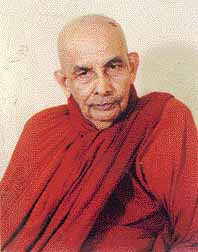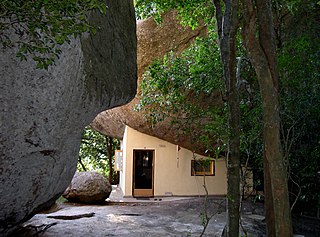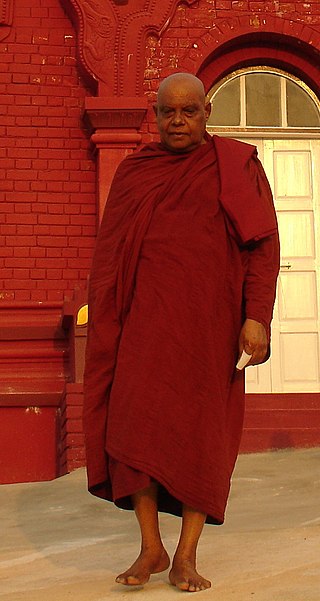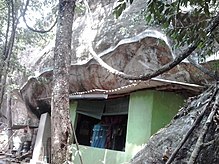Theravāda is the most commonly accepted name of Buddhism's oldest existing school. The school's adherents, termed Theravādins, have preserved their version of Gautama Buddha's teaching or Buddha Dhamma in the Pāli Canon for over two millennia.
Rāmañña Nikāya was one of the three major Buddhist orders in Sri Lanka. It was founded in 1864 when Ambagahawatte Saranankara, returned to Sri Lanka after being ordained by the Neyyadhamma Munivara Sangharaja of Ratnapunna Vihara in Burma. It was one of three Sri Lankan orthodox Buddhist monastic orders, along with Siam Nikaya and Amarapura Nikaya. On 16 August 2019, the Amarapura and Rammana Nikaya were unified as the Amarapura–Rāmañña Nikāya, making it the largest Buddhist fraternity in Sri Lanka.

Theravada Buddhism is the largest and official religion of Sri Lanka, practiced by 70.2% of the population as of 2012. Practitioners of Sri Lankan Buddhism can be found amongst the majority Sinhalese population as well as among the minority ethnic groups. Sri Lankan Buddhists share many similarities with Southeast Asian Buddhists, specifically Myanmar Buddhists and Thai Buddhists due to traditional and cultural exchange. Sri Lanka is one of five nations with a Theravada Buddhist majority.
Sangharaja is the title given in many Theravada Buddhist countries to a senior monk who is the titular head either of a monastic fraternity (nikaya), or of the Sangha throughout the country. This term is often rendered in English as 'Patriarch' or 'Supreme Patriarch'.

The Amarapura Nikaya was a Sri Lankan monastic fraternity founded in 1800. It is named after the city of Amarapura, Burma, the capital of the Konbaung dynasty of Burma at that time. Amarapura Nikaya monks are Theravada Buddhists. On 16 August 2019, the Amarapura and Ramanna Nikaya were unified as the Amarapura–Rāmañña Nikāya, making it the largest Buddhist fraternity in Sri Lanka.

Salagama (also known as Saliya is a Sinhalese caste found mostly in the southern coastal areas of Sri Lanka. The community was traditionally associated with the cultivation and management of cinnamon and were formerly also involved as weavers and soldiers.

Nyanaponika Thera or Nyanaponika Mahathera was a German-born Theravada Buddhist monk and scholar who, after ordaining in Sri Lanka, later became the co-founder of the Buddhist Publication Society and author of numerous seminal books and articles on Theravada Buddhism. He mentored and taught a whole generation of Western Buddhist leaders such as Bhikkhu Bodhi.
Nissarana Vanaya is a renowned meditation monastery in Sri Lanka. It is located in Mitirigala in the Western province close to the town of Kirindiwela.
Most Ven. Matara Sri Nanarama Maha Thera was an influential Sri Lankan meditation master, scholar and forest monk of the 20th century.

Most Venerable Madihe Pannaseeha Mahathera was an eminent Sri Lankan Buddhist monk, who was the Mahanayaka of Amarapura sect from July 13, 1969 until his death on September 9, 2003.
Śrī Kalyāṇī Yogāśrama Sansthā, also known as the Galduwa Forest Tradition is an independent part of the Sri Lankan Amarapura–Rāmañña Nikāya Buddhist ordination line, with their headquarters in Galduva, Kahawa, Ambalangoda. They keep a strict standard of Vinaya, recognised as the strictest standard of any major organisation in Sri Lanka. It is the largest forest sect of the Sri Lankan Sangha. Their monks are easily recognized by the palm-leaf umbrella they use and by the habit of wearing the Sanghati whenever they walk outside the monastery boundaries. Remarkably for Sri Lanka, all castes are accepted for ordination. Foreign monks, who wish to become resident at one of their monasteries, are usually expected to undergo the so-called "Dalhi-Kamma" at Galduva, a short ceremony meant to reconfirm the validity of their original Upasampada according to Galduva standard. After that they are accepted according to their normal seniority.

Nā Uyana Aranya Senāsanaya is a Buddhist forest monastery in Kurunegala, Sri Lanka, associated with the Sri Kalyani Yogasrama Samstha. It spreads over more than 5000 acres of forest on the 'Dummiya' mountain range and is residence to about 150 Buddhist monks. Na Uyana is so named because of the old Ceylon ironwood forest that forms part of the monastery.

Most Ven. Nauyane Ariyadhamma Maha Thera was a Sri Lankan bhikkhu and a senior meditation teacher. He was the spiritual advisor of the Sri Kalyani Yogasrama Samstha, and for many years resided at the Na Uyana Aranya. In 2011 he moved to Meetirigala Dharmayatanaya to help revitalize this long-standing place of learning and dhamma practice.
Most Ven. Kadawedduwe Sri Jinavamsa Maha Thera was a Sri Lankan (Sinhalese) Bhikkhu. He was the founder of Sri Kalyani Yogasrama Samstha, a reform movement within the Sri Lankan Rāmañña Nikāya.
A bhikkhunī or bhikṣuṇī is a fully ordained female in Buddhist monasticism. Male monastics are called bhikkhus. Both bhikkhunis and bhikkhus live by the Vinaya, a set of rules. Until recently, the lineages of female monastics only remained in Mahayana Buddhism and thus were prevalent in countries such as China, Korea, Taiwan, and Vietnam, but a few women have taken the full monastic vows in the Theravada and Vajrayana schools over the last decade. From conservative perspectives, none of the contemporary bhikkuni ordinations in Thailand or Tibet are valid.
Mahanayaka theros are high-ranking Buddhist monks who oversee and regulate the Buddhist clergy in Theravada Buddhist countries. The title Maha Nayaka translates to English as 'Great Leader' and it is considered to be a very important position held by a monk in a Theravada Buddhist country. It is usually bestowed upon the senior Buddhist monks who are appointed the chief prelates of monastic fraternities known as Nikayas.

Rerukane Chandawimala Thero was a Sri Lankan Buddhist monk and author. A personality of Sri Lankan Buddhism in the 20th century, he has been regarded as one of the finest scholars of Tripitaka, the sacred canon of Theravada Buddhism. He was also a Buddhist meditation master, professor of Abhidharma and a former Maha Nayaka of the Swegin chapter of the Amarapura Nikaya. Rerukane Chandawimala Thero was a highly reputed author of Theravada Buddhism, especially on Abhidharma. His books are considered as text books by other authors as well as students.
The history of Theravāda Buddhism begins in ancient India, where it was one of the early Buddhist schools which arose after the first schism of the Buddhist monastic community. After establishing itself in the Sri Lankan Anuradhapura Kingdom, Theravāda spread throughout mainland Southeast Asia through the efforts of missionary monks and Southeast Asian kings.
The Amarapura–Rāmañña Nikāya is the larger of the two Buddhist monastic orders in Sri Lanka, the other being the Siyam Nikāya.














